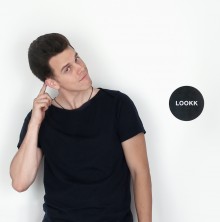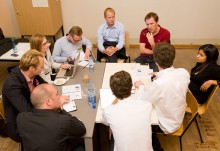
As startups from across Europe head to London for this year’s Seedcamp Week, we speak to one of last year’s participants to find out what they can expect. His experiences and tips are useful for any entrepreneurs starting out on the rocking road to success.
It’s fair to say that Seedcamp is probably the best known European tech seed investment programme. Based in London, it runs regular events across the continent, investing in a wide portfolio of companies and offering mentoring and valuable pitching experience to many more. This year’s Seedcamp Week starts on Monday and sees twenty startups participating in mentoring, masterclasses, workshops and ultimately pitching their companies to a group of top investors.
One of last year’s participating startups was Austria’s Garmz, a fashion-focused service founded by Andreas Klinger, Tamas Locher and Gilbert Wedam. We spoke to Andreas, who is also the company’s COO, to find out what Garmz got out of the week and how the year since has treated them, leading up to this week, when it relaunched itself under new name Lookk.
Lookk is a service that provides a way for fashion designers to bypass the traditional retail market and connect directly with consumers, manufacturing and selling their clothing without having to deal with retailers, the traditional gatekeepers to success in the market. Meanwhile, consumers get a chance to discover new design talent and wear clothes that they won’t find on the high street.
The Seedcamp Week experience
 Under its original name of Garmz, the startup took part in, and was one of the winners of, a ‘Mini-Seedcamp’ event in Zagreb, Croatia before moving on the Seedcamp Week in London in September 2010, where it ended up securing £50,000 investment.
Under its original name of Garmz, the startup took part in, and was one of the winners of, a ‘Mini-Seedcamp’ event in Zagreb, Croatia before moving on the Seedcamp Week in London in September 2010, where it ended up securing £50,000 investment.
Klinger describes his Seedcamp Week experience in pretty harrowing terms. “You have a table, and mentors come to you in turn, giving feedback. Their goal is to completely break you. With so many experienced people telling us we were doing so much wrong, it made us feel like giving up and going to do gardening or something else completely different instead,” he jokes. “And then when we were ready to give up, on the day before the investor pitches we were told that everything was fine – and we were like, seriously?”
That harsh criticism from knowledgeable people did however force the Garmz team to re-assess their planned pitch, making it much more about their ‘big vision’ than about specific details. It paid off and they secured investment. However, Klinger says that he is happy that Seedcamp has begun investing in some startups shortly after its ‘Mini’ events since then. “Six months is too long to wait,” he says, and considering these are often tiny startups in need of cash to help develop their ideas and simply stay alive, his point is a valid one.
The importance of location – go where your idea fits
 One of the biggest steps Garmz (now Lookk) has taken in the year since Seedcamp is to relocate from Austria to London. “In Vienna, there is a saying that ‘People who have visions should be locked away’. It’s a very different attitude to ambition. Innovation is treated with more caution than in places like Silicon Valley, and failure is seen as a bad thing rather than a learning experience.”
One of the biggest steps Garmz (now Lookk) has taken in the year since Seedcamp is to relocate from Austria to London. “In Vienna, there is a saying that ‘People who have visions should be locked away’. It’s a very different attitude to ambition. Innovation is treated with more caution than in places like Silicon Valley, and failure is seen as a bad thing rather than a learning experience.”
This is a common complaint about Europe, and a criticism that helps explain why it has fewer hit startups than the US. However, Klinger also points out that the market in Europe is far more fragmented that the States, thanks to multiple languages, cultures and jurisdictions. This makes it much harder for an idea to gain traction.
“In America you throw ideas out there and see what sticks, but in Europe you have to throw yourself in the air and hope that someone notices,” he says. “I’ve spoken to some Canadian entrepreneurs who have the same problem there, but Europe has a more fragmented market which makes it worse.”
The importance of location is one of the most important lessons that Klinger says he has learned in the year since Seedcamp. “Way before Seedcamp, when we were starting out, we were advised by experienced people in central Europe to start a local entity (a startup designed for the local market) and pitch for international funding. That’s just not going to happen.We had a naive idea to pitch to investors for ‘1 million’ – Dollars, Pounds, Euros, it didn’t matter.”
With the experience of Seedcamp under its belt, Garmz expanded its outlook – but why move to London rather than the USA? Klinger says that you should always move to the location that’s best for your business. With his startup’s focus on fashion, Europe was the obvious choice. “Don’t complain about not being in Silicon Valley. Move there if your idea is perfect for Silicon Valley, move to China if your idea is perfect for there – move where is best for you.”
“Since Seedcamp, we realised that we could network on international level. One of our investors is (prominent fashion entrepreneur) Carmen Busquets. People like this open doors. We could never get these people in Austria – fashion is just not big there.”
In addition to being close to the heart of the fashion industry, a London location also made it easier for the startup to base its technical staff in eastern Europe, where costs are lower, without losing that ‘team spirit’ that can be an important factor in success. “Just make sure there’s strong communication. It’s easy for people to burn out if they don’t know what’s happening in the company,” says Klinger. Having a short flying time between the management team in London and the technical team in eastern Europe certainly helps in this respect.
Refining the concept and becoming Lookk – thinking ‘lean’
Klinger admits that Garmz was too complex an idea initially. “It’s better to start simple and build from there. I’m a big fan of the ‘lean startup’ idea. Every ‘and’ in your product description lowers your chances of investment.”
So, the initial concept evolved into this week’s relaunch as Lookk. “We took a look at where we wanted to go. Having taken a step back, the new name reflects our vision better.”
Why the double ‘k’? “There are lots of explanations for this, but really it’s because we like it. We had huge brainstorming sessions and went through hundreds of names. Lookk just ‘stuck’.”
Klinger believes that Lookk will open up a new section of the market, leveraging new designers and bringing them to an eager audience of consumers. “There are lots of ways we can innovate,” he says. “There’s lots of room for new ideas as fashion innovates slowly.”
Advice for Seedcamp startups
 So, what advice would Andreas Klinger give to startups taking part in Seedcamp Week? Firstly, it’s to do your homework about what the mentors can do for you. “Take the time seriously and focus on your weaknesses. Step away from your pride and identify your weaknesses to make the most of your time with mentors. Accept people have different opinions – it’s not about convincing them that you’re right, it’s about getting feedback.”
So, what advice would Andreas Klinger give to startups taking part in Seedcamp Week? Firstly, it’s to do your homework about what the mentors can do for you. “Take the time seriously and focus on your weaknesses. Step away from your pride and identify your weaknesses to make the most of your time with mentors. Accept people have different opinions – it’s not about convincing them that you’re right, it’s about getting feedback.”
“Explain what you do and get to your questions for each mentor in as soon as possible, otherwise they’ll keep asking you their own questions about you. It’s more helpful to ask them what you want to know. You will hear things that sound obvious, but it’s not that they’re trying to be smart, they’re just trying to help.”
Klinger also advises startups to make the most of the whole week – not just the formal sessions. “Manage your time to make most of everything – even lunch and the evening events. It’s an exhausting week, so that’s harder than it sounds.”
The Next Web will be attending Seedcamp Week to meet this year’s participating startups, so look out for more coverage of the event soon.
Get the TNW newsletter
Get the most important tech news in your inbox each week.






